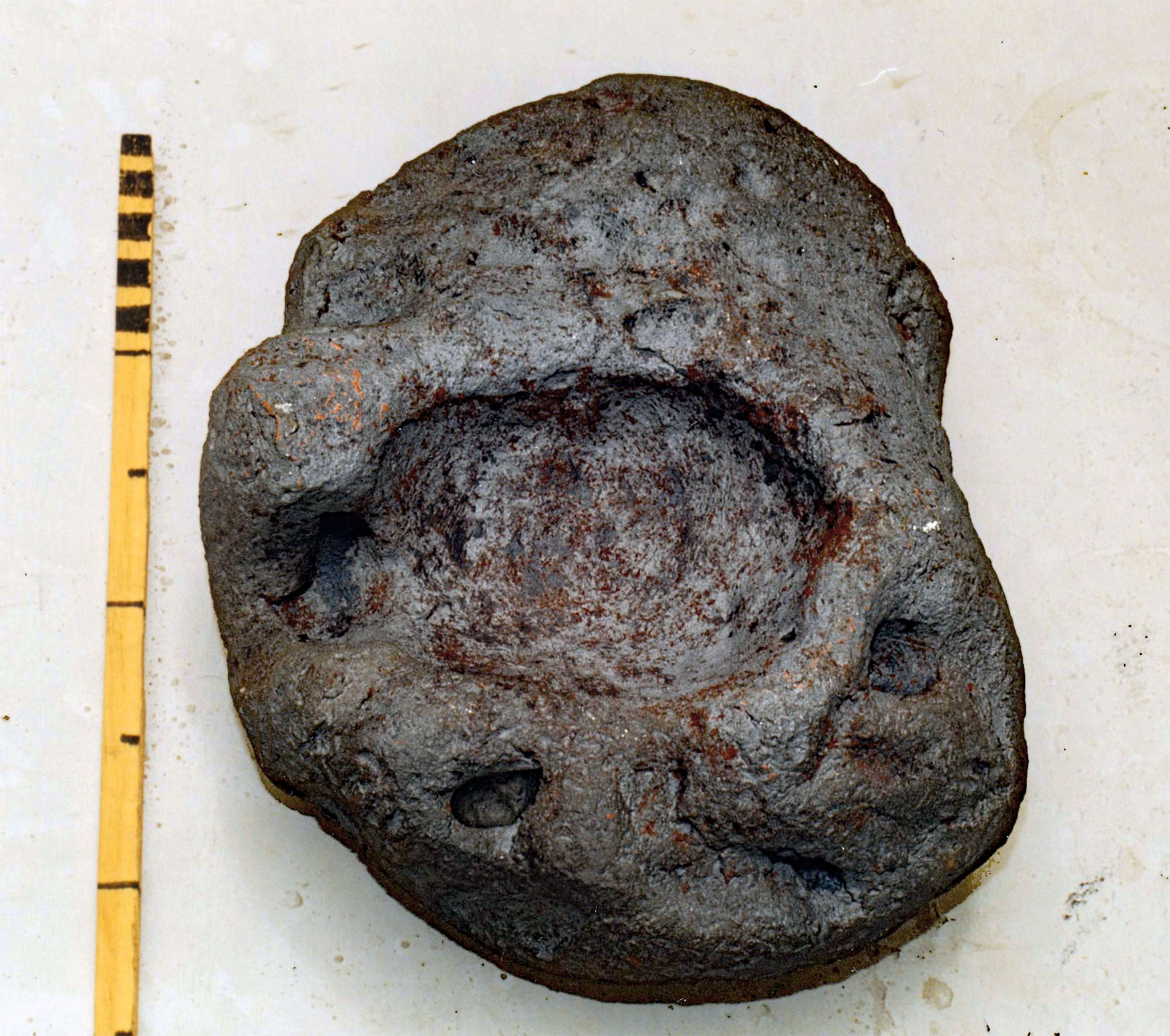|
Roll Overs:
#1
#2
#3
#4
#5
#6
#7
#8
#9
|

|
34.6 kg. 32.6 x 26.0 x 11.5 cm. Iron, IAB-ung
TKW 1280 grams (go figure). Fall not observed. Found 1959, Atacama, Chile.
Photo Credits:
Zina Fihl: 2, 3
Claudio Canut de Bon: 1, 4, 6, 7, 8
Holger Pedersen: 5, 9 (stitched panorama of Cerro Arrayan from the South, 1988)
  
Holger writes:
I have twice met with
staff from the Algarrobo-mine (once in the field, and a second
time when they brought a 100-ton crane to ESO-La Silla, for help
with telescope construction). And twice, I met with
Sr. Pizarro's widow and daughter, seeking information.
In 1985, Lindner and Buchwald wrote:
About 1959 an iron meteorite was found by a mule-driver in the
neighborhood of the iron mine Algarrobo, Chile.
The sample which is here examined is a slice of 502 g in the Delft
Collection, but it is clear that more must
exist, and it is said that the mule-driver "collected a basket
full," i.e. a total of 10-20 kg? [...]
There is visible plastic deformation at one end, suggesting that
the specimen separated violently in
mid-air from other specimens, supporting the story that the
mule-driver collected several specimens.
Confirming this supposition, I can report that one mass, 34.6 kilogram,
was found already in the year 1936,
by a handy-man of the said mine, Sr. Manuel Pizarro. A hand-drawn map
exists, showing the find location on the
south-western flank of the 1607 m mountain 'Arrayan', some 8 km
north-north-west of the mine camp & main gate,
and west of a mine rail-way. On the official 1:50,000 map (which is
available only as a poor photocopy) the
mountain is named 'Cerro Perdi..(?)', while 'Cerro Arrayan' is 1200 m
north-north-west. The position is 28.7266 degrees S,
70.9776 degrees W - which is some 200 km from that currently reported in
'Meteoritical Bulletin Database'.
For many years the mass was in possession of Compaņia de Acero del
Pacifico (a company formerly in Dutch possession),
La Serena; it is now in La Serena University's mineralogical museum
'Ignacio Domeyko', c/o Claudio Canut de Bon.
The mass is rather flat, about 32.6 by 26.0 by 11.5 cm, with large and
deep depressions. The minimum material
thickness is about 2 cm. The side which faced upward during the years at
CAP is more rusty than the rest. In 1977 a
commercial laboratory examined chips from a drill-hole, finding 91.14 %
Fe and 8.06 % Ni.
In 1994 Canut de Bon undertook to separate an end-piece, 7 by 12 cm, by
hacksawing. In 1998 this was studied metallurgically by
Vagn F. Buchwald, who confirmed its identity to the first-mentioned
slice. Part of the end-piece remains in Geological Museum,
Copenhagen (inventory number 2016.95); the rest was returned to the La
Serena museum.
Manuel Pizarro was a small-scale copper miner of his own, goat-keeper
and muleteer; his nick-name among miners of Algarrobo was
'El Pionero'. With his family, he lived right outside of the main-gate,
having been expelled, when the mine put up a fence.
During his life-long roaming of the mountains around the mine, he
assembled a collection of interesting minerals
(no meteorites preserved) and natural history objects, and took
photographs of petroglyphs he had discovered. Pizarro retired
to Vallenar and died some time before 1988. In the history of the iron
mine (Blokhuis 1987), Pizarro is praised for his
memory and sharp eye-sight; the meteorite is not mentioned.
By tradition, Chilean small-scale miners employ leather ruck-sacks,
downward-pointed, for transport of minerals, not baskets.
Ascending 'apires' would typically carry loads of 75 - 100 kg to the
surface (ref. Darwin: Voyage of the Beagle).
Holger Pedersen, March 2018.
L. Lindner and V. F. Buchwald (1985), Meteoritics 20, p.699.
G.L. Blockhuis (1987): El Mineral del Algarrobo. Historia de un gran
yacimiento de fierro.
Compaņia de Acero del Pacífico. Santiago de Chile. 104 p.
|
Click to view larger photos
#1
#2
#3
#4
#5
#6
#7
#8
#9
|
Found at the arrow (green or red) on the map below
|
|
| |
Matthias
3/17/2018 2:43:09 AM |
I can only simply agree, Paul, Anne - it is THE Buchwald.
And thank you Holger for sharing both the pics as well as the story with us. Utmost interesting. |
Paul Swartz (MPOD web master)
3/16/2018 1:54:36 PM |
I share Anne Black's sentiments, Dr. Buchwald. The Handbook of Iron Meteorites is a masterpiece and a delight to read! |
Anne Black
3/16/2018 11:41:41 AM |
I am impressed!! I don't know if anyone of you noticed but we had a visit by no less than Dr. Buchwald himself! Thank you Dr. Buchwald for looking at MPOD, and for your book, it is a gold mine of information. No meteorite collector should be without it. |
Stephen Amara
3/16/2018 5:53:14 AM |
Disproportionate TNW to photographed iron for sure lol. |
John Divelbiss
3/16/2018 5:52:35 AM |
awesome "individual" shape, and the size of a large frisbee. the scale is easy to understand in the photo at the bottom of the Met-link page. |
Stephen Amara
3/16/2018 5:48:17 AM |
Very interesting Iron, I agree that this is a great story as well. Hopefully more can be found!! |
Juergen / jnmczurich
3/16/2018 4:34:27 AM |
Holger, thanks for the great story behind this meteorite. |
vagn buchwald
3/16/2018 1:04:53 AM |
Interesting and valuable new information about this south american meteorite |
| |
|